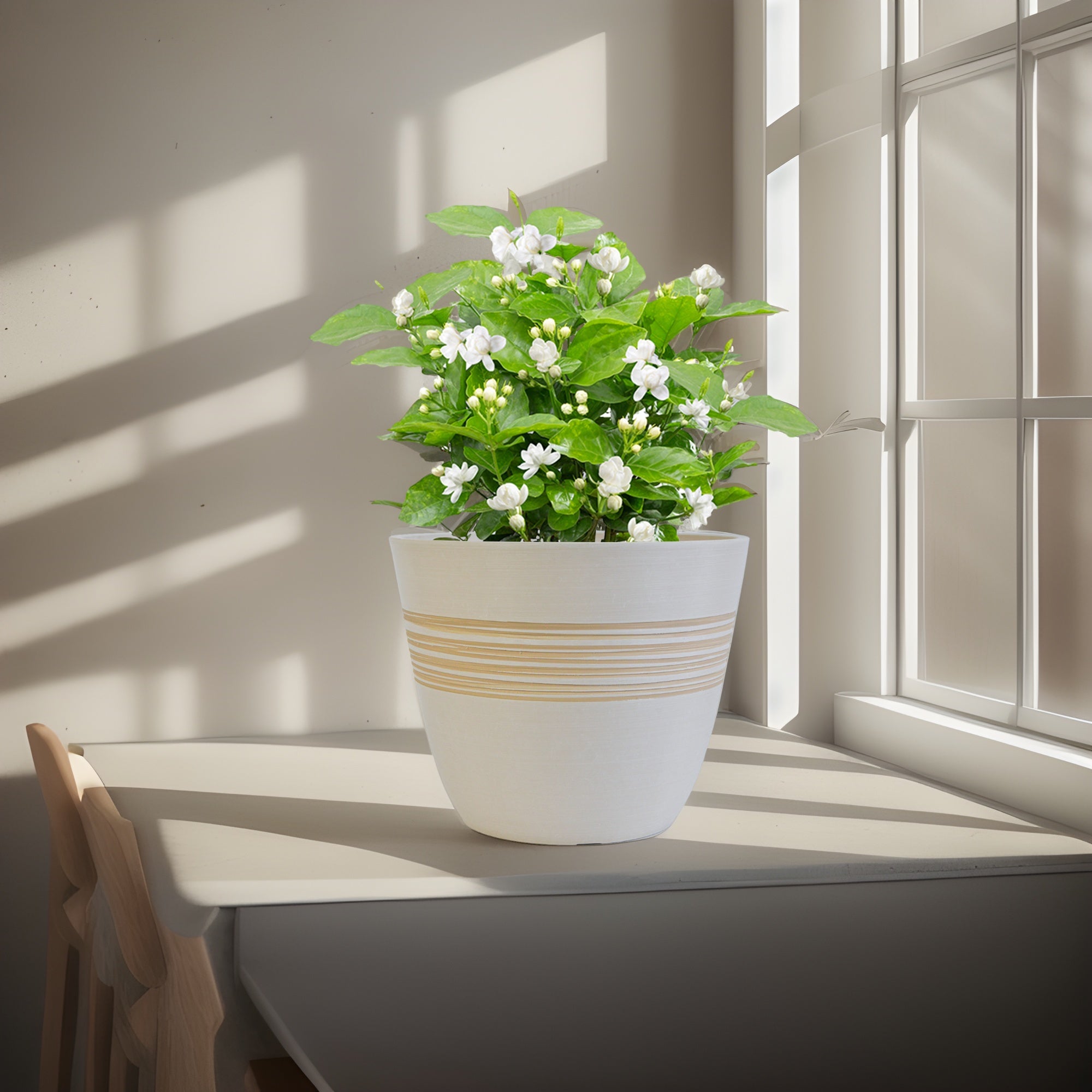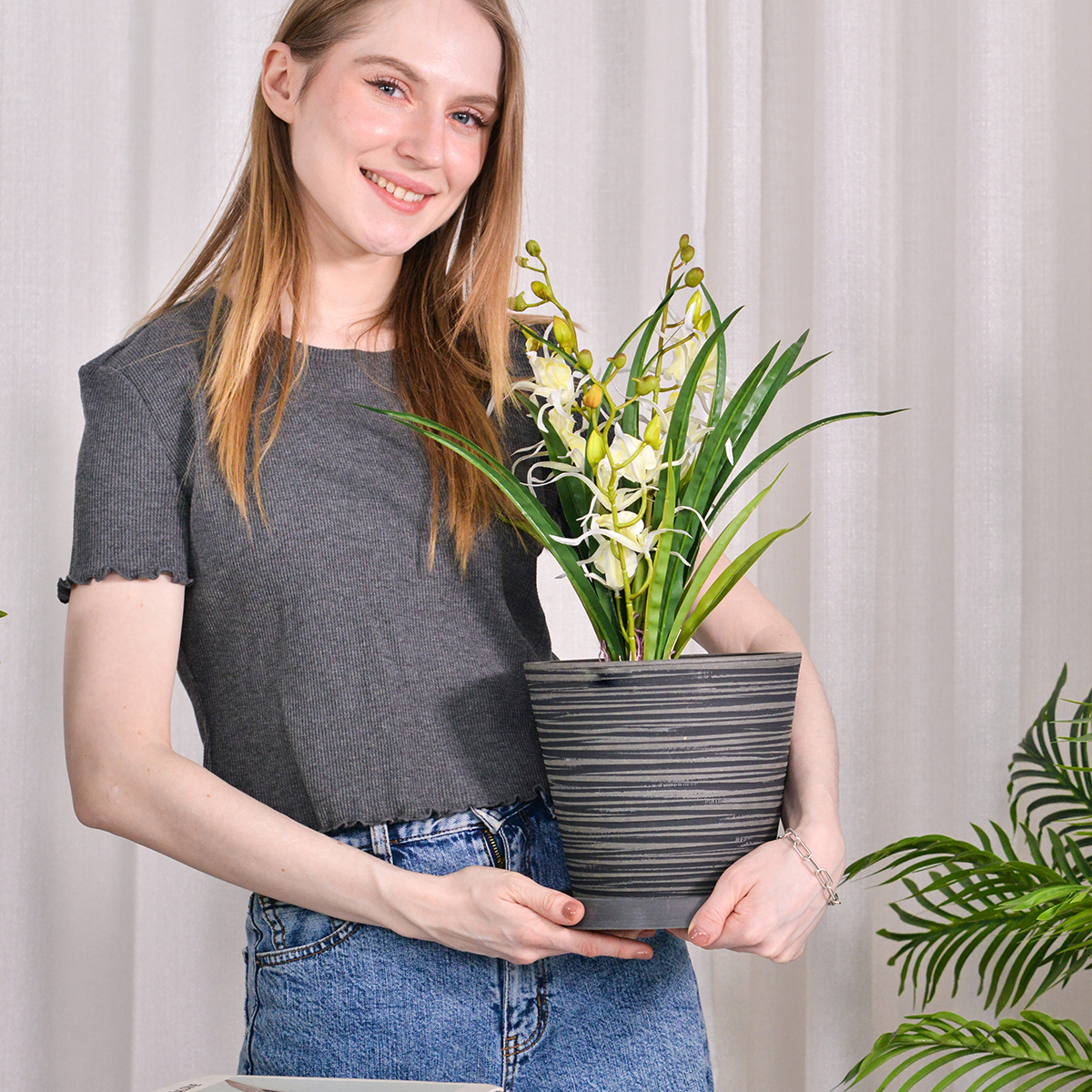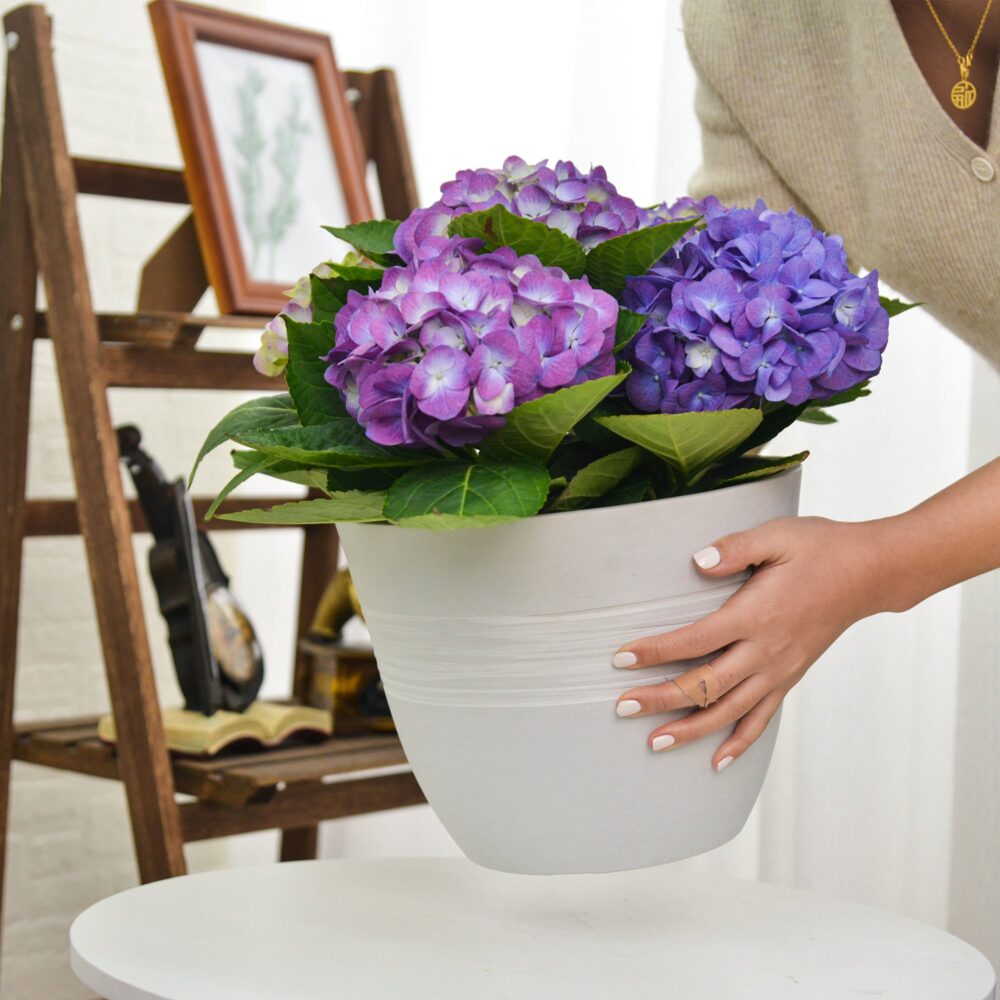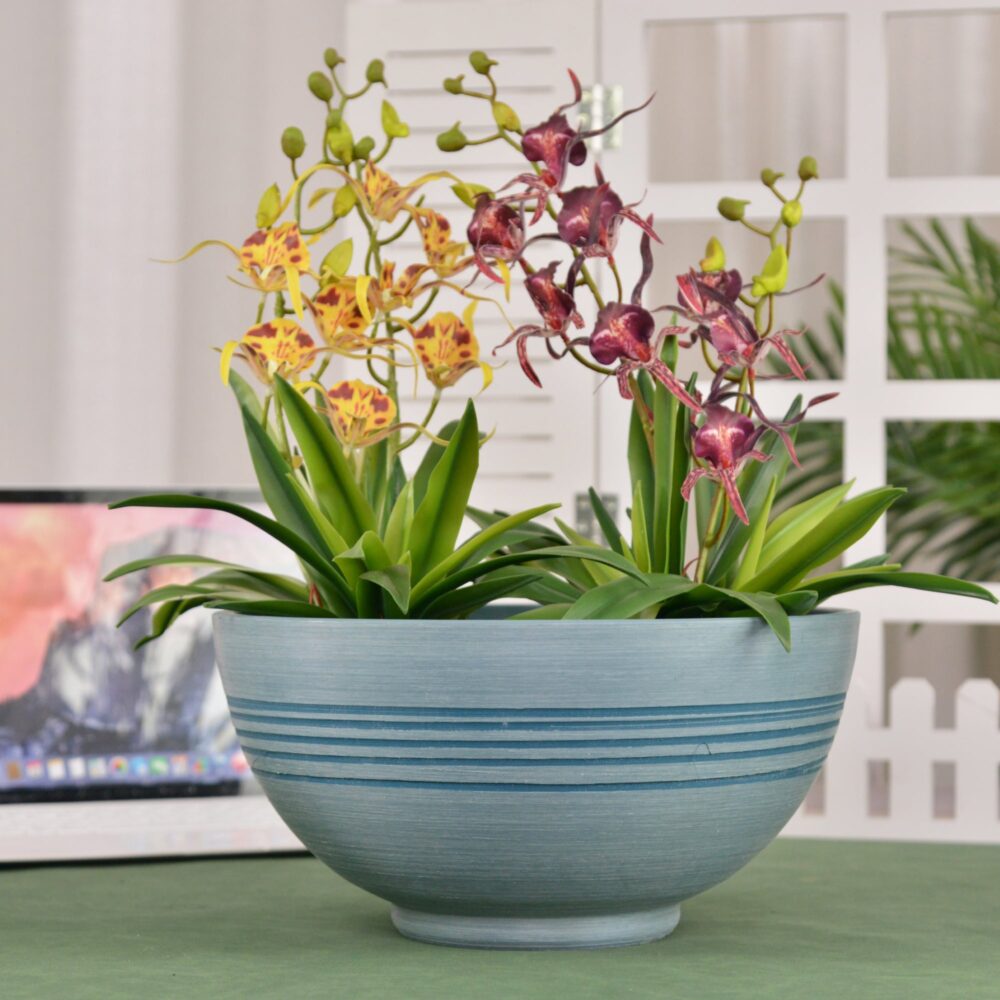Anthurium Indoors: The Complete Guide to Growing Anthurium Andraeanum at Home
Looking to add a touch of exotic flair and vibrant, long-lasting color to your indoor plant collection? Anthuriums, specifically Anthurium andraeanum (also known as Flamingo Flower or Laceleaf), are stunning houseplants prized for their glossy, heart-shaped leaves and brightly colored, waxy “flowers” that can bloom for months. These eye-catching and relatively easy-to-grow plants, belonging to the Araceae family and native to Colombia and Ecuador, are perfect for adding a tropical touch and enduring beauty to your indoor spaces. This comprehensive guide will provide you with everything you need to know to grow Anthurium andraeanum indoors, from selecting the right varieties and pots to mastering essential care techniques for a thriving and spectacularly blooming Anthurium in your home.
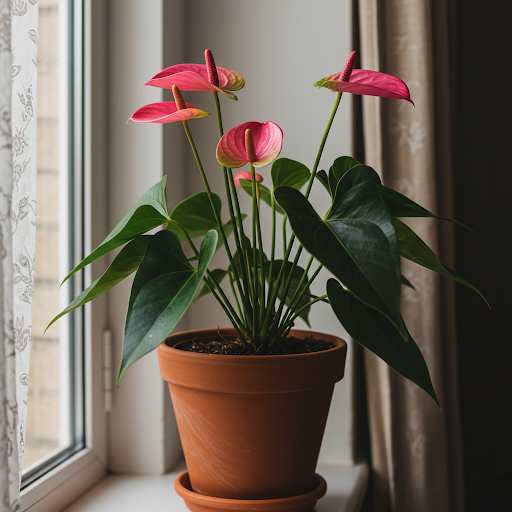
Anthuriums
What is Anthurium Andraeanum?
Anthurium andraeanum, commonly known as Anthurium, Flamingo Flower, Laceleaf, or Tailflower, is a popular species within the Anthurium genus, celebrated for its striking, heart-shaped spathes (the colorful, petal-like “flower”) and prominent spadix (the flower spike in the center of the spathe). The true flowers are tiny and located on the spadix. Anthurium andraeanum is known for its glossy, dark green leaves and long-lasting, waxy spathes that come in a range of vibrant colors, including red, pink, white, orange, and purple. It is a tropical plant prized for its exotic appearance and ability to bloom indoors for extended periods.
Can Anthurium Andraeanum Thrive Indoors?
Yes, Anthurium andraeanum thrives exceptionally well indoors and is a popular choice for houseplants. Its preference for warm, humid conditions and bright, indirect light aligns well with typical indoor environments. With proper care, Anthuriums can bloom almost continuously indoors, providing months of vibrant color and tropical elegance to your home.
Ideal Indoor Growing Conditions for Anthurium Andraeanum:
- Anthurium Varieties for Indoors: Anthurium andraeanum is the primary species grown as Flamingo Flower, and extensive hybridization has resulted in a wide array of cultivars offering diverse spathe colors, sizes, and forms. Popular indoor Anthurium varieties include:
- Red Anthuriums: Classic red spathes, cultivars like ‘Red Champion’, ‘President’, ‘Arizona’.
- Pink Anthuriums: Various shades of pink, cultivars like ‘Pink Champion’, ‘Pink Lady’, ‘Utah’.
- White Anthuriums: Elegant white spathes, cultivars like ‘White Heart’, ‘Alaska’, ‘Snowdrift’.
- Orange Anthuriums: Vibrant orange spathes, cultivars like ‘Orange Hot’, ‘Jungle King’.
- Purple and Lavender Anthuriums: Unique purple and lavender hues, cultivars like ‘Purple Heart’, ‘Lavender Lady’.
- Bicolor Anthuriums: Spathes with multiple colors or shades, often variegated or edged.
- Miniature Anthuriums: Smaller varieties, ideal for desks and smaller pots, like ‘ ছোট Sweetheart’.
- Light: Anthuriums prefer bright, indirect light. They thrive in locations that receive bright, filtered sunlight for several hours per day. East or north-facing windows are often ideal. South or west-facing windows can work if the light is filtered through sheer curtains or if the plant is placed slightly away from the window to avoid intense direct sun. Direct, intense sunlight can scorch the leaves and spathes. Insufficient light will reduce blooming and can lead to leggy growth.
- Soil: Anthuriums need well-draining, airy soil that retains some moisture. Orchid mix or an aroid mix are excellent choices, providing the necessary drainage and aeration that Anthuriums prefer. You can also create your own mix using a combination of peat moss, perlite, orchid bark, and coco coir to ensure good drainage and aeration while retaining some moisture. Avoid heavy, compact potting mixes.
- Watering: Anthuriums prefer consistently moist soil but are sensitive to overwatering and soggy conditions. Water when the top inch of soil just begins to feel slightly dry. Water thoroughly until water drains out of the drainage holes. Never let the soil dry out completely, but also avoid letting the plant sit in standing water, which can lead to root rot. Watering frequency will vary depending on light levels, temperature, humidity, and pot size. Check soil moisture regularly. Reduce watering slightly in winter when growth slows down. Use room temperature water.
- Temperature: Anthuriums thrive in warm temperatures between 65°F to 85°F (18°C to 29°C). Average room temperatures are ideal. Avoid exposing them to temperatures below 60°F (15°C) or sudden temperature fluctuations and cold drafts. They are tropical plants and prefer warmth and consistent temperatures.
- Humidity: Anthuriums thrive in high humidity, mimicking their rainforest origins. Aim for humidity levels of 60-80% or higher. High humidity is crucial for healthy growth, vibrant spathe color, and preventing leaf tip browning. Increase humidity by:
- Misting Frequently: Mist the leaves and aerial roots frequently with room temperature water, especially in the mornings and evenings.
- Pebble Trays: Place pots on trays filled with pebbles and water (water level below the pot base).
- Humidifier: Use a room humidifier, especially during dry seasons or winter heating.
- Grouping Plants: Grouping Anthuriums with other humidity-loving plants can create a more humid microclimate.
- Terrariums (Open or Partially Closed): Anthuriums can be grown in open or partially closed terrariums, which help maintain humidity. Ensure some ventilation to prevent excessive moisture buildup.
- Bathroom (if suitable light): A well-lit bathroom can be an ideal location due to naturally higher humidity.
Planting Your Anthurium Andraeanum Indoors:
- Starting from Potted Plants or Divisions: The easiest way to start growing Anthuriums indoors is to purchase established potted plants from nurseries, garden centers, or online retailers specializing in tropical plants. They can also be propagated by divisions when repotting mature plants.
- Propagation by Division: When repotting a mature Anthurium, you can gently divide the plant at the root ball, separating it into sections, ensuring each section has roots, leaves, and ideally a growth point or two. Plant each division in its own pot.
- Planting Time: Anthuriums can be planted or repotted at any time of year indoors. Spring or early summer, at the start of the growing season, is generally recommended for optimal establishment and growth.
Choosing the Right Pots for Indoor Anthurium Andraeanum:
- Suitable Pot Types: Select pots with excellent drainage and good aeration. Orchid pots, plastic pots, or ceramic pots are all suitable. Orchid pots with extra drainage holes and slits are particularly beneficial for Anthuriums, providing the airy root environment they prefer. Plastic pots are often a good choice as they are lightweight and help retain moisture, while still allowing for good drainage when used with an appropriate mix.
- Drainage: Drainage is absolutely critical for Anthuriums to prevent root rot. Ensure your chosen pot has large drainage holes at the bottom. Using an airy potting mix is equally important.
- Pot Size: Choose a pot that is only slightly larger than the root ball. Anthuriums prefer to be slightly root-bound and do not need large pots. Overpotting (using too large a pot) is a common mistake and greatly increases the risk of root rot. When repotting, typically move up only slightly in pot size. Pots that are wider than they are deep are often suitable for Anthuriums.
- Potting Mix: Use an orchid mix, aroid mix, or a well-draining, airy mix as described earlier.
Essential Care Tips for Thriving Indoor Anthuriums (Anthurium andraeanum):
- Watering Schedule: “Keep Soil Moist, Never Soggy”. Water regularly to maintain consistently moist soil. Check soil moisture frequently and water when the top inch of soil just begins to feel slightly dry. Never allow the soil to dry out completely, but also avoid overwatering and soggy soil.
- Humidity is Key to Vibrant Blooms and Foliage: Maintain high humidity levels. Frequent misting, pebble trays, humidifiers, or grouping plants are essential for preventing leaf tip browning and encouraging vibrant spathe color and healthy growth.
- Light Management for Blooms: Provide bright, indirect light to encourage blooming. Insufficient light will reduce or prevent flowering. Avoid direct sun.
- Fertilizing for Continuous Blooms: Anthuriums are moderate feeders and benefit from regular fertilization to support their continuous blooming. Fertilize every 4-6 weeks during the growing season (spring and summer) and less frequently in fall and winter with a balanced liquid fertilizer diluted to half strength, or a fertilizer specifically formulated for orchids or flowering plants. Follow package instructions.
- Deadheading Spent Flowers: Remove spent or faded spathes promptly by cutting the flower stem back to the base of the plant. This encourages the plant to produce more blooms and maintains a tidy appearance.
- Leaf Cleaning: The glossy leaves of Anthuriums can collect dust. Wipe the leaves with a damp cloth occasionally to keep them clean and glossy and allow them to photosynthesize efficiently.
- Air Circulation: Good air circulation is beneficial to help prevent fungal diseases, especially in humid conditions.
- Repotting Schedule: Repot Anthuriums every 1-2 years, or when they become root-bound or the potting mix is depleted. Repot in spring or early summer. Repotting into fresh, airy mix is beneficial for their root health and blooming.
- Pest and Disease Control: Monitor Anthuriums for pests like spider mites, mealybugs, aphids, and scale insects. Root rot is the most common disease issue, caused by overwatering and poor drainage. Ensure proper drainage, airy mix, and avoid overwatering to prevent root rot. Treat any pest infestations promptly with insecticidal soap or neem oil. Fungal and bacterial leaf spot diseases can sometimes occur in humid conditions; ensure good air circulation and avoid overhead watering if possible.
Popular Anthurium Andraeanum Cultivars and Color Variations:
- Red Anthuriums: ‘Red Champion’, ‘President’, ‘Arizona’, ‘ Королевский Red’.
- Pink Anthuriums: ‘Pink Champion’, ‘Pink Lady’, ‘Utah’, ‘ розовый Perfection’.
- White Anthuriums: ‘White Heart’, ‘Alaska’, ‘Snowdrift’, ‘ Белый Giant’.
- Orange Anthuriums: ‘Orange Hot’, ‘Jungle King’, ‘ оранжевый Queen’.
- Purple and Lavender Anthuriums: ‘Purple Heart’, ‘Lavender Lady’, ‘ фиолетовый Majesty’.
- Bicolor Anthuriums: ‘Jungle Bush’, ‘ жаккардовый’, ‘ Graffiti’.
- Miniature Anthuriums: ‘ ছোট Sweetheart’, ‘ Baby Boomer’.
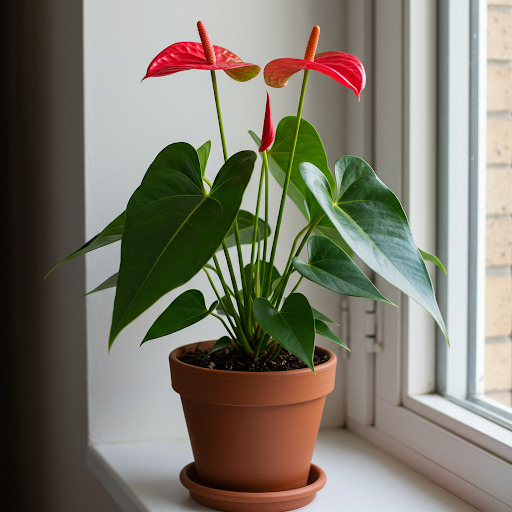
Anthuriums
In Summary:
Growing Anthurium Andraeanum indoors is a rewarding way to bring exotic beauty and long-lasting color to your home. Their striking spathes and glossy foliage make them a standout houseplant. By providing bright, indirect light, airy and well-draining orchid or aroid mix, consistent moisture (but not soggy), high humidity, and regular care, you can easily cultivate thriving and spectacularly blooming Anthuriums indoors and enjoy their tropical elegance year after year.
For more detailed botanical information and to explore the diversity of Anthurium species, you can visit the Wikipedia page on Anthurium.
Important Note: Anthuriums (Anthurium) are considered mildly toxic if ingested due to calcium oxalate crystals, which can cause mouth and stomach irritation if consumed. Keep them out of reach of children and pets who may be tempted to chew on the spathes or leaves. The sap can also be mildly irritating to skin in some individuals, so wash hands after handling.
Planter for Indoor Outdoor Plants, Set of 2 Modern Decorative Plant Pots with Drainage Hole, Decorative Flower Pots
By greenship-seo|2025-04-10T07:46:01+00:00January 9, 2025|Categories: Hand-carving Series|Tags: Decorative Flower Pots, Self-Watering Pots|
K2-11T
By greenship|2024-08-13T04:21:25+00:00August 13, 2024|Categories: Hand-carving Series|
Planter for Indoor Outdoor Plants, Set of 2 Modern Decorative Plant Pots with Drainage Hole, Decorative Flower Pots
By greenship-seo|2025-01-14T12:26:44+00:00January 14, 2025|Categories: Hand-carving Series|Tags: Decorative Flower Pots|
Modern Plant Pots with Drainage – Indoor & Outdoor Use (6″ Widths)
By greenship-seo|2025-04-10T06:29:43+00:00February 6, 2025|Categories: Hand-carving Series|Tags: Decorative Flower Pots|
KC2-21G
By greenship|2024-08-13T06:19:08+00:00August 13, 2024|Categories: Hand-carving Series|
13 inch Planter for Indoor Plants, Set of 2 Modern Decorative Plant Pots with Drainage Hole, Cute Bowl Shape Flower Pots
By greenship-seo|2025-04-10T07:41:46+00:00January 10, 2025|Categories: Hand-carving Series|Tags: Decorative Flower Pots, Self-Watering Pots|

